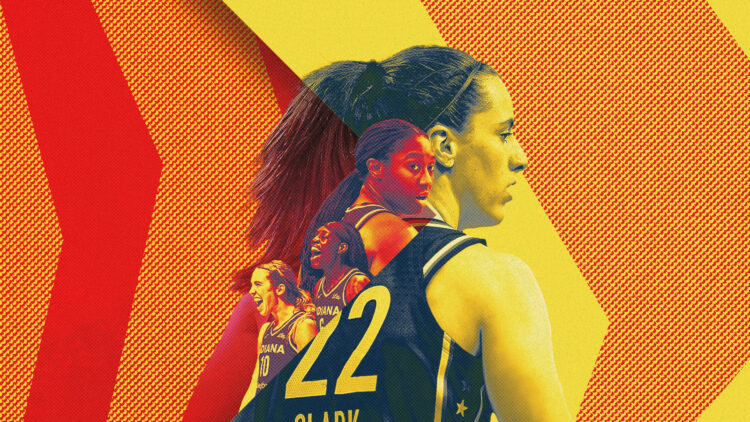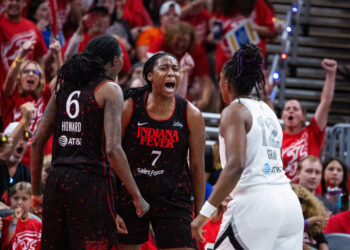The injury bug that befell Caitlin Clark was the greatest thing that could have happened to this Indiana Fever era.
Okay, maybe that’s hyperbole, but take a walk with me.
People always expected them to be good in 2025. The Fever entered the 2025 season with raised expectations and heightened attention. After a transformative offseason that saw longtime veterans DeWanna Bonner, Sophie Cunningham, Brianna Turner, and Natasha Howard join the ranks, Indiana was clearly ushering in a new era surrounding Caitlin Clark and Aliyah Boston.
May started with growing pains, as they went 2-4, navigating chemistry issues and early injury bugs. Late in the month, the team announced that Clark would miss two weeks with a quad injury, and they struggled with turnovers and inconsistent shooting. Still, flashes of potential emerged, especially from the supporting cast, with Kelsey Mitchell taking on a larger scoring load.
June brought modest improvement and a stronger sense of identity. Indiana finished the month 6–4, finding a groove defensively while slowly tightening their rotations. They signed Aari McDonald to help with bench depth. Boston was a consistent force in the paint, while Clark began to regain her rhythm, posting several near triple-doubles. They also leaned into a faster-paced, transition-heavy offense that better suited their young roster. Unfortunately, Clark’s name appeared on the injury report once more, this time because of a left groin strain.
July was the team’s best month, both record-wise (8–4) and in terms of cohesion. The Fever looked like a legitimate playoff threat, thanks in part to improved bench production and Clark playing her most confident basketball of the season, until just before the All-Star break, when she suffered a right groin injury. While Indiana entered the break above .500 for the first time in years, with Boston earning her second All-Star nod, the conversation around Clark dimmed. She would not play another game for the rest of the season.
August and September brought some expected regression — a 4–6 stretch cooled their momentum — but by then, they had largely secured their playoff spot. Fatigue, minor injuries, and a difficult late-season schedule tested their resilience, but they held on to finish 24-20 overall, earning a mid-tier playoff seed.
Making the playoffs as a sixth-seed certainly fell short of expectations, but considering the team was without its best player and another of its better perimeter shooters and emotional leaders in Sophie Cunningham, it was the best the team could’ve hoped for.
No one expected much out of this team in their first-round matchup against the Dream, except a few very smart people.
IYKYK https://t.co/Xp2xg3crWF pic.twitter.com/ZHRCgFLv5Z
— Matt Cohen (@byMattCohen) September 19, 2025
The Fever won a hard-fought battle against Atlanta, winning the final two and the decisive game on the road.
One could be forgiven if the Fever were still not the favorites against the Las Vegas Aces in the semis. Without their key pieces, it wasn’t expected to last long, but the Fever took the Aces the distance, losing in five games.
So why would I argue that Clark’s absence was so crucial if her presence may have turned the tide for the Fever in the semis?
Even with Clark, there’s no certainty of their being there. With Clark, the Fever were a good team—not a great one. And yes, that’s not a knock on Clark herself, who did exactly what was asked of her, often to an unreasonable degree. But that’s the issue: too much of this team’s identity, execution, and ceiling were tied up in her doing everything. When your entire game plan starts and ends with “give Caitlin the ball and figure it out,” you’re not building a system — you’re building a dependency.
And while that kind of star-centric system can work in theory, in practice, it leaves a lot on the table. At best, her teammates were left waiting for chances. At worst, they were missing in action — not for lack of talent, but for lack of rhythm, confidence, and meaningful touches to develop. The result? A team that often looked disjointed, reactive, and unsure of what to do when Clark wasn’t magic. That’s not sustainable. That’s not championship basketball.
But then something funny happened. Clark missed time. The calculus changed, and suddenly, the system had to work without her. Players like Boston, Howard, and Mitchell stepped up — not because they suddenly got better, but because the structure finally asked more of them. Guard Lexie Hull rounded into a true two-way threat, becoming a consistent offensive threat and finished the season as their third scoring option. The ball moved. The floor spaced. Head coach Stephanie White’s game plan wasn’t “give it to Caitlin and pray” — it was balanced, dynamic, and surprisingly effective. The Fever didn’t just stay afloat; they proved they belonged. They won a playoff series. They took the eventual champs to the brink. That’s not nothing.
And now, here’s the twist: that version of the Fever — the one with structure, belief, and a proven system — is a far more enticing destination than just “Caitlin Clark and friends.” With a murky CBA ahead and tons of cap flexibility, Indiana has a rare window. Players saw what this team can do without their star, which makes the version with her that much more terrifying. For the first time in over a decade, the Fever aren’t just hoping for relevance. They’re building for something real. Something sustained; something bigger than one player — even if that one player is Caitlin Clark.















